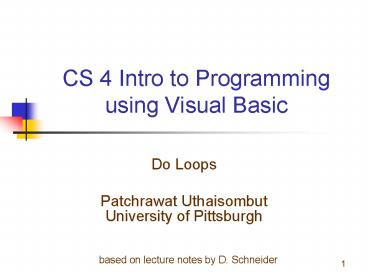CS 4 Intro to Programming using Visual Basic - PowerPoint PPT Presentation
1 / 23
Title:
CS 4 Intro to Programming using Visual Basic
Description:
How do we construct the right string on each line of the List Box? ( How do we construct the string '5 * 1 = 5', etc. ?) P. Uthaisombut. 7. Technical Issues ... – PowerPoint PPT presentation
Number of Views:62
Avg rating:3.0/5.0
Title: CS 4 Intro to Programming using Visual Basic
1
CS 4 Intro to Programming using Visual Basic
- Do Loops
- Patchrawat UthaisombutUniversity of Pittsburgh
based on lecture notes by D. Schneider
2
Chapter 6 Repetition
- 6.1 Do Loops
- 6.2 Processing Lists of Data with Do
- Loops
- 6.3 For...Next Loops
- 6.4 A Case Study Analyze a Loan
3
How to write the following program?
- The user inputs a number x.
- The program displays the multiplication table for
x.
4
User Interface Design
- Use a Text Box to accept a number
- Use a Button to accept the print table command
from the user - Use a List Box to show the multiplication table.
- Put a Label near the Text Box to give a brief
instruction to the user
5
User Interface Design
6
Expected Results
7
Technical issues
- When does the program respond to the user?
- How do we convert text input from the Text Box
into an integer? - How do we add a line into a List Box?
- How do we construct the right string on each line
of the List Box? (How do we construct the string
5 1 5, etc. ?)
8
Technical Issues
- How do we add exactly 12 lines into the List Box?
9
One solution
- Put 12 lstTable.Items.Add() in the code
- But there is a better solution
10
6.1 Do Loops
- A loop is one of the most important structures in
programming. - Used to repeat a sequence of statements a number
of times. - The Do loop repeats a sequence of statements
either as long as or until a certain condition is
true.
11
Do Loop Syntax
Condition is tested, If it is True, the loop is
run. If it is False, the statements following
the Loop statement are executed.
- Do While condition
- statement(s)
- Loop
These statements are inside the body of the loop
and are run if the condition above is True.
12
Pseudocode and Flow Chart for a Do Loop
13
Simple Illustration of Do Loop
- When the user click the button, display 1, 2,, 7
on the List Box.
14
Example 1
- Private Sub btnDisplay_Click(...) _
- Handles btnDisplay.Click
- 'Display the numbers from 1 to 7
- Dim num As Integer 1
- Do While num lt 7
- lstNumbers.Items.Add(num)
- num 1 'Add 1 to the value of num
- Loop
- End Sub
15
Back to our multiplication table
- Public Class Form1
- Private Sub btnDisplay_Click() Handles
btnDisplay.Click - Dim x As Integer
- Dim y As Integer
- x CInt(txtInput.Text)
- y 1
- Do While y lt 12
- lstTable.Items.Add(x " " y "
" x y) - y 1
- Loop
- End Sub
- End Class
16
Example Repeat Request as Long as Response in
Incorrect
- Dim passWord As String ""
- Do While passWord ltgt "SHAZAM"
- passWord InputBox("What is the password?")
- passWord passWord.ToUpper
- Loop
passWord is the loop control variable because the
value stored in passWord is what is tested to
determine if the loop should continue or stop.
17
Post Test Loop
- Do
- statement(s)
- Loop Until condition
Loop is executed once and then the condition is
tested. If it is False, the loop is run again. If
it is True, the statements following the Loop
statement are executed.
18
Example Repeat Request Until Proper Response is
Given
- Do
- passWord InputBox("What is the password?")
- passWord passWord.ToUpper
- Loop Until passWord "SHAZAM"
19
Pseudocode and Flowchart for a Post-Test Loop
20
Example 4 Form
txtAmount
txtWhen
21
Example 4 Code
- Private Sub btnCalculate_Click(...) Handles
- btnCalculate.Click
- Dim balance As Double, numYears As Integer
- balance CDbl(txtAmount.Text)
- Do While balance lt 1000000
- balance 0.06 balance
- numYears 1
- Loop
- txtWhen.Text "In " numYears _
- " years you will have a million dollars."
- End Sub
22
Example 4 Output
23
Comments
- Be careful to avoid infinite loops loops that
never end. - Visual Basic allows for the use of either the
While keyword or the Until keyword at the top or
the bottom of a loop. - This textbook will use only While at the top and
only Until at the bottom.































